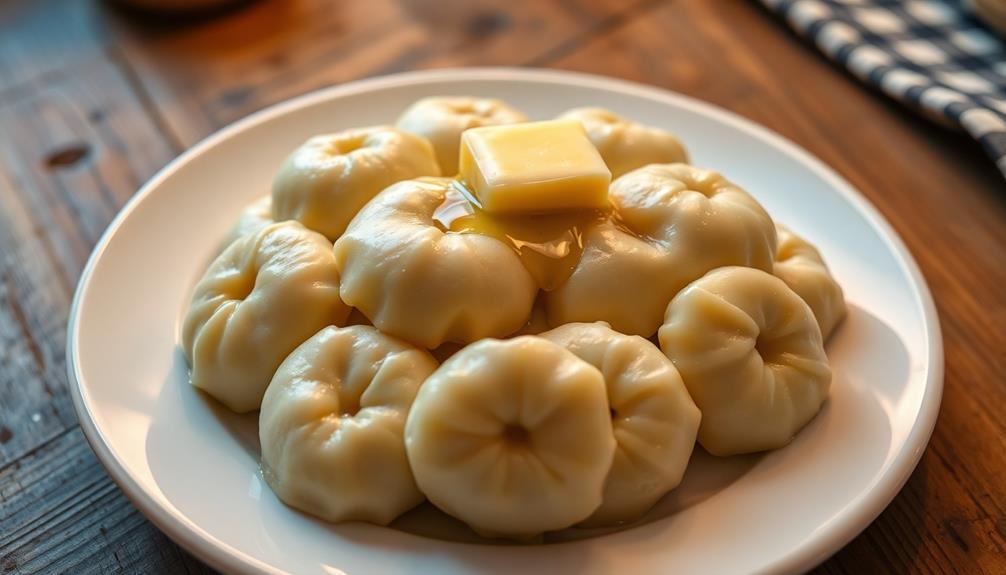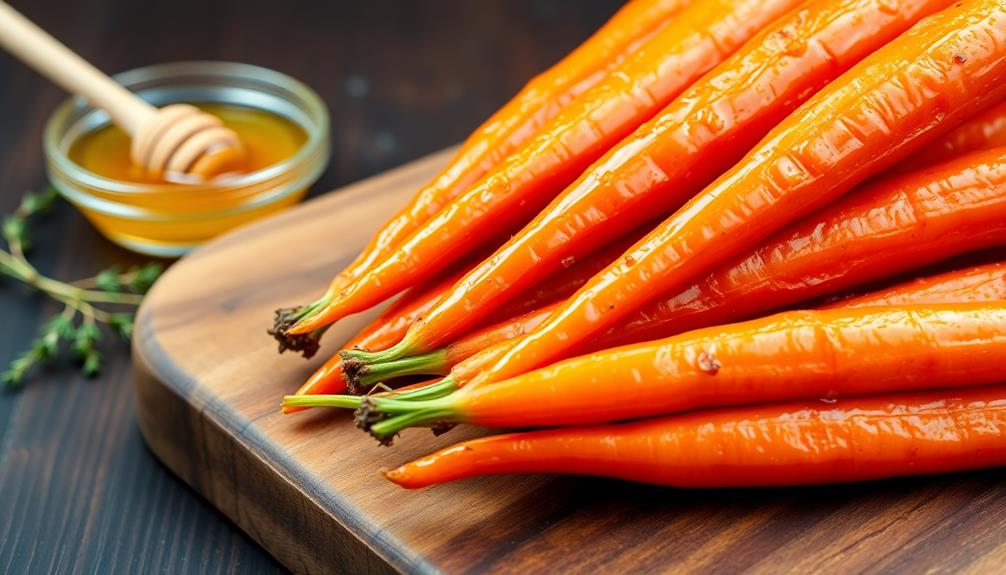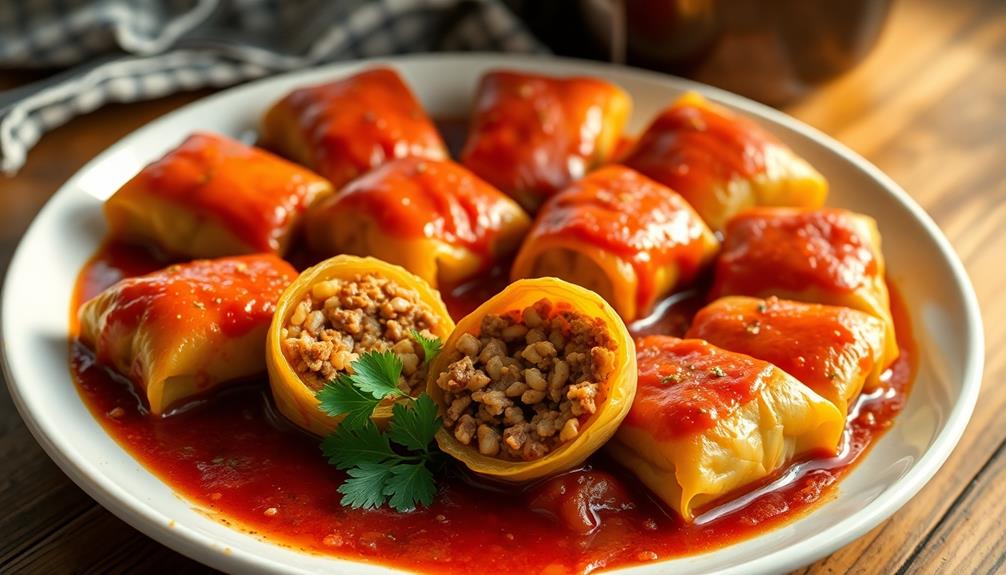Silesian dumplings, also known as "kluski śląskie," are a beloved comfort food from Eastern Europe. You'll love these soft, pillowy potato dumplings with their signature dimple in the center. They're made with simple ingredients like grated potatoes, flour, and egg, then boiled until they float to perfection. Serve them with melted butter or rich gravies for a truly satisfying meal. These dumplings have a rich history, reflecting the resourceful spirit of Silesia. They're perfect for both casual dinners and festive gatherings, symbolizing regional pride and tradition. If you're eager to explore authentic cuisines, this dish offers a tasty journey through Silesian culture.
Key Takeaways
- Silesian dumplings are traditional potato dumplings originating from the Silesia region, spanning parts of Poland, Germany, and the Czech Republic.
- Known as "kluski śląskie" in Polish or "Kartoffelknödel" in German, they're characterized by a round shape with a central indentation.
- Key ingredients include mashed potatoes, potato starch, egg, and salt, resulting in a soft, chewy texture.
- Preparation involves grating potatoes, mixing with flour and egg, shaping into balls, and boiling until they float.
- Typically served with melted butter or rich gravies, these dumplings are versatile and can accompany various dishes.
History
Silesian dumplings, known locally as "kluski śląskie," have a rich history dating back centuries. You'll find these tasty treats deeply rooted in the culinary traditions of Silesia, a region that spans parts of Poland, Germany, and the Czech Republic.
As you explore their past, you'll discover that these dumplings were born out of necessity and creativity. In the old days, Silesian families made the most of their limited ingredients. They'd mix potato with flour to create a hearty, filling meal that could sustain hardworking farmers and miners.
You can imagine how these humble dumplings became a staple on dinner tables across the region!
Over time, kluski śląskie evolved into a beloved comfort food. They've been passed down through generations, with each family adding their own special touch.
Today, you'll find these dumplings served at festive gatherings and in cozy homes alike. They're a symbol of Silesian pride and a delicious reminder of the region's resourceful spirit.
When you taste them, you're not just enjoying a meal – you're savoring a piece of history!
Recipe
Silesian dumplings, also known as "kluski śląskie" in Polish, are a traditional dish from the Silesia region. These unique dumplings are characterized by their round shape with a small indentation in the center, giving them a distinctive appearance. They're typically served as a side dish to complement hearty meat-based meals.
The key to perfect Silesian dumplings lies in achieving the right consistency of the dough. Made primarily from mashed potatoes and potato starch, these dumplings have a slightly chewy texture and a mild potato flavor. The addition of an egg helps bind the ingredients together, resulting in a smooth and pliable dough that's easy to shape.
Ingredients:
- 2 pounds potatoes, peeled and quartered
- 1 cup potato starch
- 1 large egg
- 1/2 teaspoon salt
- Water for boiling
To prepare Silesian dumplings, start by boiling the peeled potatoes until tender. Drain and mash them thoroughly while still hot. Allow the mashed potatoes to cool slightly, then add the potato starch, egg, and salt. Mix well to form a smooth dough.
Shape the dough into small balls, about 1.5 inches in diameter, making a small indentation in the center of each with your thumb. Bring a large pot of salted water to a boil and carefully drop the dumplings in. Cook for about 3-4 minutes or until they float to the surface. Remove with a slotted spoon and serve immediately.
For best results, use starchy potatoes like Russet or Idaho for a fluffier texture. Be careful not to overwork the dough, as this can make the dumplings tough. If the dough feels too sticky, add a little more potato starch. Conversely, if it's too dry, you can add a small amount of the potato cooking water.
Serve the dumplings with a pat of butter or alongside gravy-rich dishes to fully appreciate their delicate flavor and texture.
Cooking Steps
To make delicious Silesian dumplings, you'll start by finely grating potatoes and mixing them with flour and egg to form a dough.
Next, you'll shape this dough into small, bite-sized balls that are perfect for boiling.
Step 1. Grate Potatoes Finely
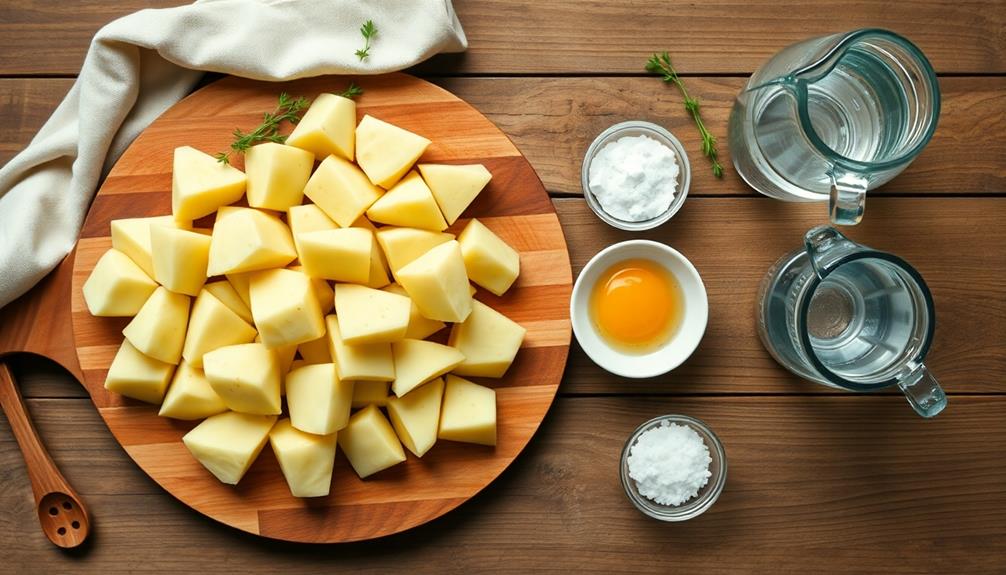
Precision is key when grating potatoes for Silesian dumplings. You'll want to use a fine grater or food processor to achieve the perfect texture.
Start by washing and peeling your potatoes, then grate them immediately to prevent browning. As you grate, you'll notice the potatoes releasing water – this is normal and essential for the dumplings' consistency.
Work quickly and efficiently, letting the potato shreds fall into a large bowl. You'll see a pile of finely grated potatoes growing before your eyes! It's amazing how much volume they lose in this process.
Once you've grated all your potatoes, you'll need to remove excess moisture. Grab a clean kitchen towel or cheesecloth and squeeze the grated potatoes firmly. You'll be surprised by how much liquid comes out!
Don't worry if your arms get a bit tired – it's all part of the dumpling-making adventure. The drier your potato mixture, the better your dumplings will turn out.
Step 2. Mix With Flour and Egg
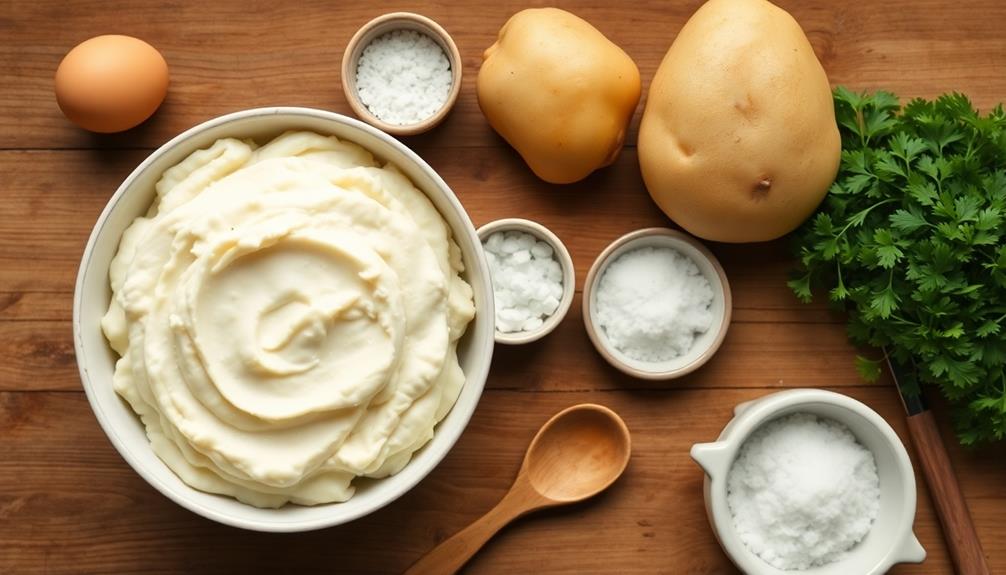
Now that you've grated and squeezed your potatoes, it's time to mix them with flour and egg. In a large bowl, combine your potato mass with about 1/3 cup of all-purpose flour for every 2 pounds of potatoes. The flour helps bind the dumplings together, so they don't fall apart when cooking.
Crack one egg into the mixture for every 2 pounds of potatoes as well. The egg adds richness and acts as another binding agent.
Using your hands, gently mix the ingredients together. You'll feel the texture change as you work, becoming smoother and more cohesive.
Don't overmix, though! You want the dumplings to be light, not tough. The mixture should be slightly sticky but hold its shape when you form a small ball. If it's too wet, add a bit more flour, tablespoon by tablespoon. If it's too dry, you can add a splash of milk or water.
Step 3. Form Dough Into Small Balls
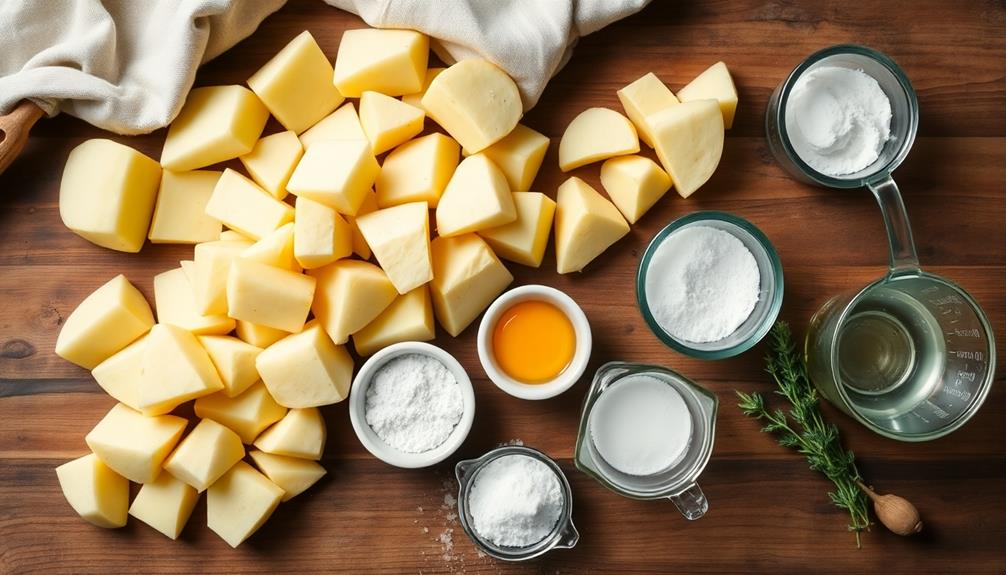
Grab a handful of the prepared dough and start shaping it into small balls. You'll want them to be about the size of a large marble or a small ping-pong ball. Roll the dough between your palms, applying gentle pressure to create a smooth, round surface.
As you form each ball, place it on a lightly floured surface to prevent sticking. Continue this process until you've used up all the dough. You'll notice that the balls are soft yet hold their shape well.
Don't worry if they're not perfectly uniform – that's part of their homemade charm! As you work, you might find that the dough becomes a bit sticky. If this happens, dust your hands with a little flour to make handling easier.
Step 4. Boil Dumplings Until Floating
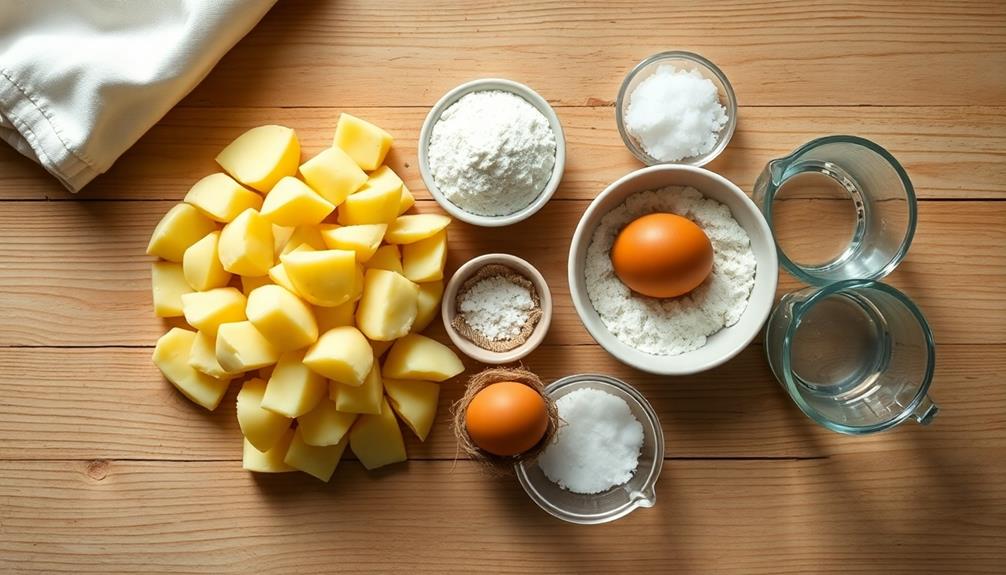
With the dumplings shaped, it's time to cook them. Fill a large pot with water and bring it to a rolling boil. Add a pinch of salt to enhance the flavor. Using a slotted spoon, carefully lower the dumplings into the boiling water. Be sure not to overcrowd the pot – it’s best to cook them in batches. Allow the dumplings to cook for about 5-7 minutes, or until they float to the surface. This is a traditional pierogi recipe that has been passed down in my family for generations.
Gently drop the dumplings into the water, one by one. Don't overcrowd the pot; cook them in batches if needed.
As the dumplings cook, you'll notice they sink to the bottom at first. Keep an eye on them, and you'll soon see them start to rise. This is exciting!
When they float to the surface, they're almost ready. Let them bob around for another 1-2 minutes to ensure they're cooked through.
Using a slotted spoon, carefully remove the floating dumplings from the water. They'll be hot and delicate, so handle them with care.
Place them on a warm plate or in a bowl. You can drizzle some melted butter over them to keep them from sticking together.
Repeat the process with any remaining dumplings. Your Silesian dumplings are now ready to serve and enjoy!
Step 5. Serve With Melted Butter
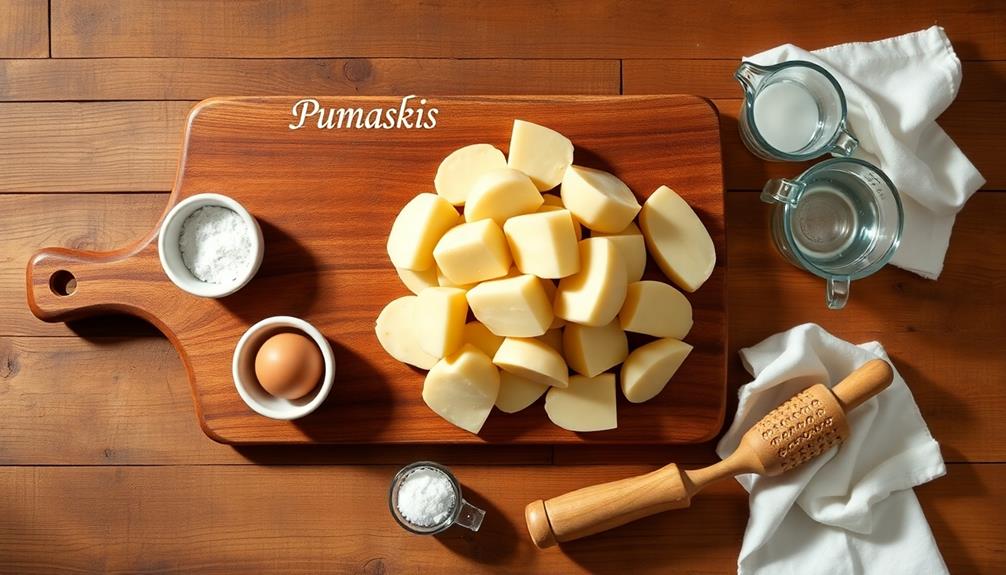
After cooking your Silesian dumplings to perfection, it's time to add the finishing touch. Melted butter is the classic way to serve these delicious potato dumplings, and it's so easy to do!
Simply melt a generous amount of butter in a small saucepan over low heat. Be careful not to let it burn – you want it warm and golden, not brown.
Once your butter is melted, transfer your cooked dumplings to a serving dish. Drizzle the warm, liquid gold over the top, making sure to coat each dumpling evenly. You'll see the butter pooling in the nooks and crannies, creating a mouthwatering sight.
The rich, creamy butter complements the slightly chewy texture of the dumplings perfectly.
For an extra touch, sprinkle some chopped fresh herbs like parsley or chives over the top. This adds a pop of color and a fresh flavor that balances the richness of the butter.
Now your Silesian dumplings are ready to serve! Watch as your family and friends eagerly dig in, savoring every buttery bite of this comforting dish.
Final Thoughts
To wrap up, Silesian dumplings are a delightful culinary gem that's worth trying. You'll find these little potato pillows to be a comforting and satisfying addition to your meals. They're not only tasty but also versatile, pairing well with various dishes and sauces.
As you've learned, making Silesian dumplings isn't too complicated. With a bit of practice, you'll be shaping perfect indentations like a pro. Remember, the key is in the right potato-to-flour ratio and getting that signature dimple just right.
Don't be afraid to experiment with different toppings or fillings. While traditionalists might stick to melted butter or gravy, you can get creative and try them with cheese, herbs, or even as a sweet treat with fruit compote.
Silesian dumplings are more than just food; they're a piece of cultural heritage. By making and enjoying them, you're connecting with centuries of tradition.
Frequently Asked Questions
Can Kluski ŚLąSkie Be Frozen for Later Use?
Yes, you can freeze kluski śląskie for later use! These tasty dumplings are perfect for meal prep.
After cooking, let them cool completely. Then, spread them on a baking sheet and pop them in the freezer until solid.
Once frozen, transfer them to a freezer-safe bag or container. They'll keep for up to 3 months.
When you're ready to enjoy them, just thaw and reheat. It's a great way to save time and always have a delicious side dish on hand!
Are There Any Vegetarian or Vegan Versions of Kluski ŚLąSkie?
Yes, you can make vegetarian or vegan versions of these dumplings!
For a vegetarian option, simply leave out the meat and use vegetable broth instead.
To make them vegan, you'll need to replace the eggs with a plant-based binder like mashed potatoes or flax eggs.
You can also experiment with different flours, like chickpea or almond flour, to add flavor and nutrition.
Don't forget to top your veggie dumplings with tasty plant-based sauces or gravy for extra yumminess!
What Are Traditional Side Dishes Served With Kluski ŚLąSkie?
When you're enjoying these delicious dumplings, you'll often find them paired with tasty side dishes. Traditional favorites include hearty beef roulades, rich gravy, and tangy sauerkraut.
You might also see colorful braised red cabbage, crisp cucumber salad, or flavorful mushroom sauce on the plate.
Don't forget about the classic roasted meats like pork or chicken! These sides complement the dumplings perfectly, creating a satisfying and comforting meal that'll warm your heart and fill your belly.
How Long Do Leftover Kluski ŚLąSkie Stay Fresh in the Refrigerator?
You'll want to enjoy your leftover dumplings within 3-4 days for the best taste and quality.
Make sure you store them in an airtight container in your fridge. They'll stay fresh and yummy if you keep them chilled.
When you're ready to eat, just reheat them gently.
Remember, if they start to smell odd or look different, it's best to toss them out.
Always trust your senses to keep yourself safe and healthy!
Can Kluski ŚLąSkie Be Made With Alternative Flours for Gluten-Free Diets?
Yes, you can make these dumplings gluten-free! Try using alternative flours like rice flour, potato starch, or a gluten-free blend.
You'll need to experiment a bit to get the right texture, but don't give up! Remember, the dough might feel different when you're working with it.
Start with small batches and adjust as needed. You might also want to add a binding agent like xanthan gum to help hold the dumplings together.
It's a fun challenge that'll open up new tasty possibilities!
